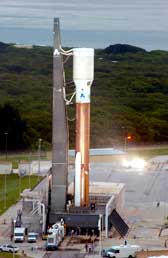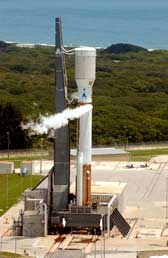 |
 |
|
||||
|
|
||||
|
BY JUSTIN RAY Follow the preparations and launch of the Lockheed Martin Atlas 5 rocket carrying the Rainbow 1 communications satellite. Reload this page for the very latest on the mission.
2147 GMT (5:47 p.m. EDT)
2144 GMT (5:44 p.m. EDT) The Atlas liquid oxygen tank is the largest tank to be filled today. The propellant for the first stage -- the RP-1 kerosene -- was loaded aboard the rocket during a recent countdown dress rehearsal. The kerosene is considered storable and can be loaded into the rocket ahead of time. However, the liquid oxygen and liquid hydrogen cryogenics being pumped into the rocket this afternoon are chilled to several hundred degrees below zero and naturally boil away. Therefore they have be loaded rather close to launch.
2143 GMT (5:43 p.m. EDT)
2142 GMT (5:42 p.m. EDT)
2137 GMT (5:37 p.m. EDT)
2132 GMT (5:31 p.m. EDT)
2123 GMT (5:23 p.m. EDT) The liquid oxygen -- chilled to Minus-298 degrees F -- will be consumed during the launch by the Centaur's single RL10 engine along with liquid hydrogen to be pumped into the stage a little later in the countdown.
2115 GMT (5:15 p.m. EDT) There is one Collision Avoidance blackout period, or COLA, during this evening's launch window that will prohibit liftoff for a few minutes. The COLA extends from 8:38:58 to 8:45:40 p.m. EDT. The Air Force computes COLAs to ensure the Atlas 5 isn't launched on a trajectory that would take it too close to an object already in space.
2110 GMT (5:10 p.m. EDT) Activities upcoming include pressurizing the RP-1 first stage fuel tank and liquid oxygen chilldown procedures.
2102 GMT (5:02 p.m. EDT)
2055 GMT (4:55 p.m. EDT)
2040 GMT (4:40 p.m. EDT)
2015 GMT (4:15 p.m. EDT)
1930 GMT (3:30 p.m. EDT) At the present time, all launch weather rules at Cape Canaveral are "go".
1750 GMT (1:50 p.m. EDT) The rocket has been powered up at the Complex 41 launch pad as the countdown progresses for the 7:20 p.m. EDT liftoff this evening. Fueling operations remains targeted to begin around 5:30 p.m. "Everything is working fine," Atlas Launch Director Adrian Laffitte told reporters at the pre-launch news conference a short time ago. "We are about 45 minutes ahead of the count. We did that on purpose just in case (a lightning warning) kicks us off the pad," Laffitte said in reference to thunderstorms around Central Florida that could force workers to clear the pad, delaying pre-launch work. "We are going to be busy," Launch Weather Officer Jim Sardonia said at the news conference. "The weather team is looking at it right now and keeping Adrian's team advised of what is going on." For this evening's launch window that extends from 7:20 to 9:00 p.m. EDT, there is a 60 percent chance of acceptable weather. "We are confident that as we approach sunset that the activity will generally slow down and dissipate, and we will have at least some opportunity within that 100 minute launch window," Sardonia added. Meanwhile, the solid rocket booster retrieval team is positioned in the Atlantic Ocean for its chance to grab the Atlas 5 rocket's spent motors after they impact the water tonight. "We have been in contact with the SRB recovery ship. Fishing is good. They have caught a lot of fish. Everybody is doing well," Laffitte said. For more on the plan to possibly retrieve the boosters, see our story here.
1500 GMT (11:00 a.m. EDT)
1425 GMT (10:25 a.m. EDT) The two mobile trailers connected to the launching platform, which were part of the convoy during this morning's rollout, soon will be hooked up to power and communications systems at the pad. These trailers provide conditioned air to the payload and communications with the rocket during the roll and throughout the countdown. They are protected from the blast of launch by a concrete structure on the north-side of the platform. Within the next hour, the auto couplers between the pad and platform will be engaged to route umbilical connections from the ground to the rocket. At around 12:20 p.m. EDT (1620 GMT), the Atlas first stage and Centaur upper stage are scheduled to be powered up. During the next hour, testing of the rocket's guidance system will start, followed by flight control system preps. At approximately 1:45 p.m. EDT (1745 GMT), the "MEGA Door" on the Vertical Integration Facility will be sealed and efforts to clear the area of personnel begins. A variety of other standard countdown operations will continue into the mid-afternoon hours. A weather briefing is planned at 4:45 p.m. EDT (2045 GMT), just five minutes before the countdown enters a planned half-hour hold at the T-minus 2 hour point. Once the clocks resume counting, fueling activities will begin. The pre-launch news conference is coming up at 12:30 p.m. Our next update on this page will be following the briefing.
1400 GMT (10:00 a.m. EDT)
1350 GMT (9:50 a.m. EDT) Riding on the 1.4-million pound mobile launching platform, the 196-foot tall rocket is making its way along rail tracks. Arrival at the pad should occur in about a half-hour. To learn more about the "clean pad" concept used by Lockheed Martin for the Atlas 5 program, see our complete story.
1330 GMT (9:30 a.m. EDT) The countdown will begin at 10 a.m. and rollout of the rocket from its assembly building to the launch pad is expected to begin a short time later.
WEDNESDAY, JULY 16, 2003 Following the precedent set with the last Atlas 5 mission in May, the rocket is transferred to the pad, fueled and then launched in about nine hours. Thursday's liftoff is targeted to occur at 7:20 p.m. EDT (2320 GMT). Launch countdown preparations will begin at 6:20 a.m. EDT (1020 GMT). A weather update for officials is slated for 9:20 a.m. (1320 GMT) to review the forecast for the hours the rocket will be exposed to the elements on the launch pad from rollout through liftoff. A procedures briefing to launch team members will occur at 9:50 a.m. (1350 GMT). The countdown commences at 10:00 a.m. (1400 GMT) from the T-minus 8 hour, 40 minute mark. Planned holds in the count will lead to the opening of the day's 100-minute launch window. A readiness poll of team members will be conducted at 10:02 a.m. (1402 GMT) for a final "go" to roll. With no technical problems reported and acceptable weather, the mobile launcher platform should begin the 1,800-foot journey from the Vertical Integration Facility to the pad at 10:10 a.m. EDT (1410 GMT). The rollout is expected to take about a half-hour. By 11:15 a.m. EDT (1515 GMT), the mobile platform should be firmly secured in place, allowing the automatic umbilical connectors between the ground and platform to engage and begin leak checks. The next few hours will be spent powering up the rocket and running routine tests. The countdown will enter a planned half-hour hold at 4:40 p.m. EDT (2040 GMT) at the T-minus 2 hour point. Following the hold, loading of super-cold liquid oxygen and liquid hydrogen propellants into the Atlas 5 will start. A final hold is scheduled at T-minus 4 minutes and should last 10 minutes in duration. Watch this page for live updates Thursday morning during the rollout of Atlas 5! And we will provide comprehensive live reports right here throughout the countdown and launch.
1800 GMT (2:00 p.m. EDT) Launch is scheduled for 7:20 p.m. EDT (2320 GMT) at the opening of a window that extends to 9:00 p.m. EDT (0100 GMT). The exact same window is available on Friday and Saturday, if needed. The rocket will loft the Rainbow 1 direct-to-home TV broadcast satellite into geosynchronous transfer orbit. Watch this page for complete live reports throughout the countdown and flight of the Atlas 5.
1400 GMT (10:00 a.m. EDT)
TUESDAY, JULY 15, 2003 Meanwhile, today's updated weather forecast is available here.
MONDAY, JULY 14, 2003
THURSDAY, JULY 10, 2003
MONDAY, JULY 7, 2003
MONDAY, JUNE 23, 2003 Once back in the VIF, Lockheed Martin will ready the rocket to receive its payload -- the Rainbow 1 direct broadcasting spacecraft. The Atlas 5 will return to the launch pad just hours before liftoff July 17.
1630 GMT (12:30 p.m. EDT)
SUNDAY, JUNE 22, 2003 Looking different than its two predecessors that successfully launched last August and May, the Atlas 5 AV-003 rocket will be sporting two strap-on solid rocket boosters and the base for a much larger nose cone when it emerges from the Vertical Processing Facility hangar around 4 a.m. EDT Monday. Riding on the mobile launching platform, the rocket will take the half-hour trip to the pad at Cape Canaveral Air Force Station's Complex 41. By about 5 a.m., the platform should be secured at the pad for the start of preparations to fuel the rocket. About two hours later, RP-1 propellant -- a highly-refined kerosene -- will start flowing into the Atlas 5's first stage. The countdown will follow a timeline to be used July 17 during the real launch day. Countdown clocks will enter a half-hour hold at T-minus 120 minutes at 10:20 a.m. Following the planned pause, the launch team begins the steps to load the Atlas first stage and Centaur upper stage with super-cold liquid oxygen. The Centaur also will be filled with liquid hydrogen propellant. A final built-in hold will occur at T-minus 4 minutes and last for 10 minutes. The simulated liftoff time is targeted for 1 p.m. After recycling the countdown to T-minus 4 minutes, another T-0 is planned for 2 p.m., Lockheed Martin said. The rocket will remain on the pad overnight. Rollback to the Vertical Integration Facility is expected around noon Tuesday. Meanwhile, the commercial direct broadcasting communications satellite to be launched atop this Atlas 5 rocket is undergoing pre-flight preparations at the Astrotech center in nearby Titusville. After it is tested and fueled, technicians will enclose the Rainbow 1 spacecraft in the top portion of the rocket's nose cone and then transport it to the Complex 41 Vertical Integration Facility for mating to the launcher. The launch window on July 17 opens at approximately 7:20 p.m. EDT (2320 GMT) and extends for roughly an hour and 20 minutes. Originally planned to be a morning liftoff, mission managers recently shifted the launch 12 hours later. Lockheed Martin has scheduled July 17, 18 and 19 for launch opportunities. See our coverage of the inaugural Atlas 5 launch here and the second mission here.
|
Snapshots  The Atlas 5 was rolled to the pad early June 23. The rocket was fully fueled during a launch day rehearsal. Photos: Patrick H. Corkery/Lockheed Martin Mars DVD  Explore the Red Planet from the comfort of your home with this interactive DVD. Includes 3D glasses for viewing three-dimensional images of Mars. Explore the Red Planet from the comfort of your home with this interactive DVD. Includes 3D glasses for viewing three-dimensional images of Mars. |
|||